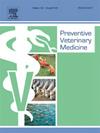Novel characterisation of sheep flocks in Wales: A description of principal flock typologies and antimicrobial use patterns
IF 2.2
2区 农林科学
Q1 VETERINARY SCIENCES
引用次数: 0
Abstract
There is increasing pressure to reduce and refine antimicrobial use (AMU) in farmed livestock, to slow the development of antimicrobial resistance (AMR) and preserve the efficacy of antimicrobials (AMs) in both humans and animals. Developing strategies to help drive the prudent use of AMs requires an understanding of the direct and indirect factors influencing the between-farm variation in AMU typically observed. Given limited evidence of risk factors in sheep, this exploratory study aimed to investigate whether sheep flocks could be classified into farm types based on farm characteristics, health parameters and management practices, and whether important differences existed in AMU between these flock types. This study was conducted on 22 sheep flocks in Wales, United Kingdom as part of a wider longitudinal study on AMU and AMR. Comprehensive surveys were administered to flocks where 147 variables regarding farm characteristics, flock health parameters and management practices were captured. AMU data for each flock were also collated. A Multiple Correspondence Analysis (MCA), followed by a Hierarchical Clustering on Principal Components (HCPC) analysis, were used to classify the flocks. The top 10 dimensions yielded by MCA explained 67.4 % of the total variance. Nine partitions of relatively homogeneous flocks, derived from three typologies produced from the first three cut-points of the HCPC dendrogram, were visualised and described. These nine partitions were characterised by 70 variable categories, principally the implementation or neglect of best-practice lameness management practices. Partitions of flocks that neglected best-practice lameness managements – characterised by delayed treatments of lame sheep, footbathing and bleeding when foot trimming – reported higher lameness prevalence and fewer lame ewes recovering within five days of treatment. These flocks had higher total AMU (mg/PCU) and used a higher mass of injectable AMs than other partitions of flocks. Flock traits, lambing practices, disease challenges and other management factors also described partitions derived in later dendrogram cuts. Findings from this study confirm good AM stewardship in sheep flocks to be a complex picture, given the typologies of flocks described and the range of factors likely to influence AMU. Opportunities for targeted strategies for sustainable reductions in AMU can be directed towards specific flock types identified, specifically within the context of lameness treatment and control. We highlight the importance of understanding flock heterogeneity, through the construction of typologies, as a means to fine-tune appropriate interventions to specific flock types in order to help drive more prudent use of AMs.
威尔士羊群的新特征:描述主要羊群类型和抗菌药使用模式。
为了减缓抗菌药耐药性(AMR)的发展并保持抗菌药(AMs)对人类和动物的疗效,减少和改进养殖牲畜抗菌药使用(AMU)的压力与日俱增。要制定有助于推动谨慎使用 AMs 的策略,就必须了解影响农场间 AMU 差异的直接和间接因素。鉴于有关绵羊风险因素的证据有限,本探索性研究旨在调查是否可根据农场特征、健康参数和管理方法将羊群划分为不同的农场类型,以及这些羊群类型之间的 AMU 是否存在重要差异。这项研究针对英国威尔士的 22 个羊群进行,是更广泛的 AMU 和 AMR 纵向研究的一部分。研究人员对羊群进行了全面调查,收集了有关农场特征、羊群健康参数和管理方法的 147 个变量。同时还整理了每个鸡群的AMU数据。采用多重对应分析(MCA)和主成分层次聚类分析(HCPC)对鸡群进行分类。多重对应分析得出的前 10 个维度解释了总方差的 67.4%。从 HCPC 树枝图的前三个切点产生的三种类型中得出了九个相对同质的鸡群分区,并对其进行了可视化描述。这九个分区由 70 个变量类别组成,主要是跛足管理最佳实践的实施或忽视情况。忽视最佳跛足管理方法的羊群(表现为延迟治疗跛足羊、足浴和修脚时出血),其跛足发病率较高,在治疗后五天内康复的跛足母羊较少。与其他地区的羊群相比,这些羊群的总AMU(毫克/PCU)更高,使用的注射AMs也更多。羊群性状、产羔方法、疾病挑战和其他管理因素也描述了在后期树枝图切割中得出的分区。这项研究的结果证实,鉴于所描述的羊群类型以及可能影响AMU的一系列因素,羊群中良好的AM管理是一个复杂的问题。可以针对特定的羊群类型,特别是在跛足治疗和控制方面,制定有针对性的策略,以持续减少AMU。我们强调通过构建类型来了解鸡群异质性的重要性,并以此为手段对特定鸡群类型的适当干预措施进行微调,以帮助推动更谨慎地使用AMs。
本文章由计算机程序翻译,如有差异,请以英文原文为准。
求助全文
约1分钟内获得全文
求助全文
来源期刊

Preventive veterinary medicine
农林科学-兽医学
CiteScore
5.60
自引率
7.70%
发文量
184
审稿时长
3 months
期刊介绍:
Preventive Veterinary Medicine is one of the leading international resources for scientific reports on animal health programs and preventive veterinary medicine. The journal follows the guidelines for standardizing and strengthening the reporting of biomedical research which are available from the CONSORT, MOOSE, PRISMA, REFLECT, STARD, and STROBE statements. The journal focuses on:
Epidemiology of health events relevant to domestic and wild animals;
Economic impacts of epidemic and endemic animal and zoonotic diseases;
Latest methods and approaches in veterinary epidemiology;
Disease and infection control or eradication measures;
The "One Health" concept and the relationships between veterinary medicine, human health, animal-production systems, and the environment;
Development of new techniques in surveillance systems and diagnosis;
Evaluation and control of diseases in animal populations.
 求助内容:
求助内容: 应助结果提醒方式:
应助结果提醒方式:


